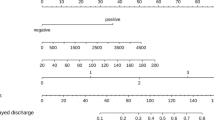Abstract
Purpose
To identify patient- and procedure-related factors that increase the risk of hospital readmission and emergency room (ER) visits after percutaneous nephrolithotomy (PNL).
Materials and methods
We retrospectively reviewed the records of patients with kidney stones treated via PNL in two tertiary referral hospitals between 2008 and 2014. Patient demographics including age, body mass indices, ASA score, stone size, presence of anatomic abnormality and comorbidity, operative and postoperative measures, and ER visit and rehospitalization rates were reviewed. Unplanned readmission to the hospital, including elective, and ER visits due to any reason related to the PNL procedure were primarily examined. The factors affecting ER visit and rehospitalization rate were analyzed using logistic regression analysis.
Results
A total of 1024 patients (mean age 46.57 years) were enrolled into the study. Mean stone size was 28.5 mm. Stone-free status was achieved in 81.7 % of the procedures. Complications occurred at a rate of 6.44 % in the postoperative period. ER visit and rehospitalization rates were 5.76 and 5.27 %, respectively. While stone complexity, anatomic abnormalities, and postoperative course were found to be factors affecting ER visit, postoperative course and hospitalization time were main predictors for rehospitalization rate.
Conclusions
Our outcomes demonstrate that patients, who had an anatomic abnormality and complex kidney stone, were more likely to have an unplanned hospital readmission. Patients with a history of perioperative and/or postoperative complication seem to have a tendency to unplanned readmission and rehospitalization.
Similar content being viewed by others
References
Hesse A, Brändle E, Wilbert D et al (2003) Study on the prevalence and incidence of urolithiasis in Germany comparing the years 1979 versus 2000. Eur Urol 44(6):709–713
Scales CD Jr, Smith AC, Hanley JM et al (2012) Urologic diseases in America project. Prevalence of kidney stones in the United States. Eur Urol 62(1):160–165. doi:10.1016/j.eururo.2012.03.052
Fernström I, Johansson B (1976) Percutaneous Pyelolithotomy: a new extraction technique. Scand J Urol Nephrol 10:257–259
Jackman SV, Hedican SP, Peters CA et al (1998) Percutaneous nephrolithotomy in infants and preschool age children: experience with a new technique. Urology 52(4):697–701
Bader MJ, Gratzke C, Seitz M et al (2011) The all-seeing needle: initial results of an optical puncture system confirming access in percutaneous nephrolithotomy. Eur Urol 59(6):1054–1059
Desai J, Solanki R (2013) Ultra-mini percutaneous nephrolithotomy (UMP): one more armamentarium. BJU Int 112(7):1046–1049. doi:10.1111/bju.12193
Litwin MS, Saigal C (2012) Urologic Diseases in America. US Department of Health and Human Services, Public Health Service, National Institutes of Health, National Institute of Diabetes and Digestive and Kidney Diseases, Washington, DC, US
Rambachan A, Matulewicz RS, Pilecki M et al (2014) Predictors of readmission following outpatient urological surgery. J Urol 192(1):183–188. doi:10.1016/j.juro.2013.12.053
Armitage JN, Withington J, van der Meulen J et al (2014) Percutaneous nephrolithotomy in England: practice and outcomes described in the hospital episode statistics database. BJU Int 113(5):777–782. doi:10.1111/bju.12373
Sfoungaristos S, Hidas G, Gofrit ON et al (2014) A novel model to predict the risk of readmission in patients with renal colic. J Endourol 28(8):1011–1015. doi:10.1089/end.2014.0082
Beiko D, Elkoushy MA, Kokorovic A et al. (2015) Ambulatory percutaneous nephrolithotomy: what is the rate of readmission?. J Endourol 29(4):410–414, doi:10.1089/end.2014.0584
Tepeler A, Armağan A, Akman T, Polat EC, Ersöz C, Topaktaş R, Erdem MR, Onol SY (2012) Impact of percutaneous renal access technique on outcomes of percutaneous nephrolithotomy. J Endourol 26(7):828–833. doi:10.1089/end.2011.0563
Rassweiler JJ, Renner C, Eisenberger F (2000) The management of complex stones. BJU Int 86:919–928
de la Rosette JJ, Opondo D, Daels FP, Giusti G, Serrano A, Kandasami SV, Wolf JS Jr, Grabe M, Gravas S, CROES PCNL Study Group (2012) Categorisation of complications and validation of the Clavien score for percutaneous nephrolithotomy. Eur Urol 62(2):246–255. doi:10.1016/j.eururo.2012.03.055
Scales CD Jr, Saigal CS, Hanley JM, Dick AW, Setodji CM, Litwin MS, NIDDK Urologic Diseases in America Project (2014) The impact of unplanned post procedure visits in the management of patients with urinary stones. Surgery 155(5):769–775. doi:10.1016/j.surg.2013.12.013
Authors’ contributions
A.T., T.K. and A.U contributed to the study design, writing and interpretation. A.Tok, E.O., S.K., and OT.K. collected the data. I.B. conducted the statistical analysis and created the figures.
Author information
Authors and Affiliations
Corresponding author
Ethics declarations
Conflict of interest
The authors declare that they have no competing interest.
Ethical standard
The study was performed in accordance with the Declaration of Helsinki and its amendments. All patients provided written informed consent.
Rights and permissions
About this article
Cite this article
Tepeler, A., Karatag, T., Tok, A. et al. Factors affecting hospital readmission and rehospitalization following percutaneous nephrolithotomy. World J Urol 34, 69–73 (2016). https://doi.org/10.1007/s00345-015-1641-1
Received:
Accepted:
Published:
Issue Date:
DOI: https://doi.org/10.1007/s00345-015-1641-1



